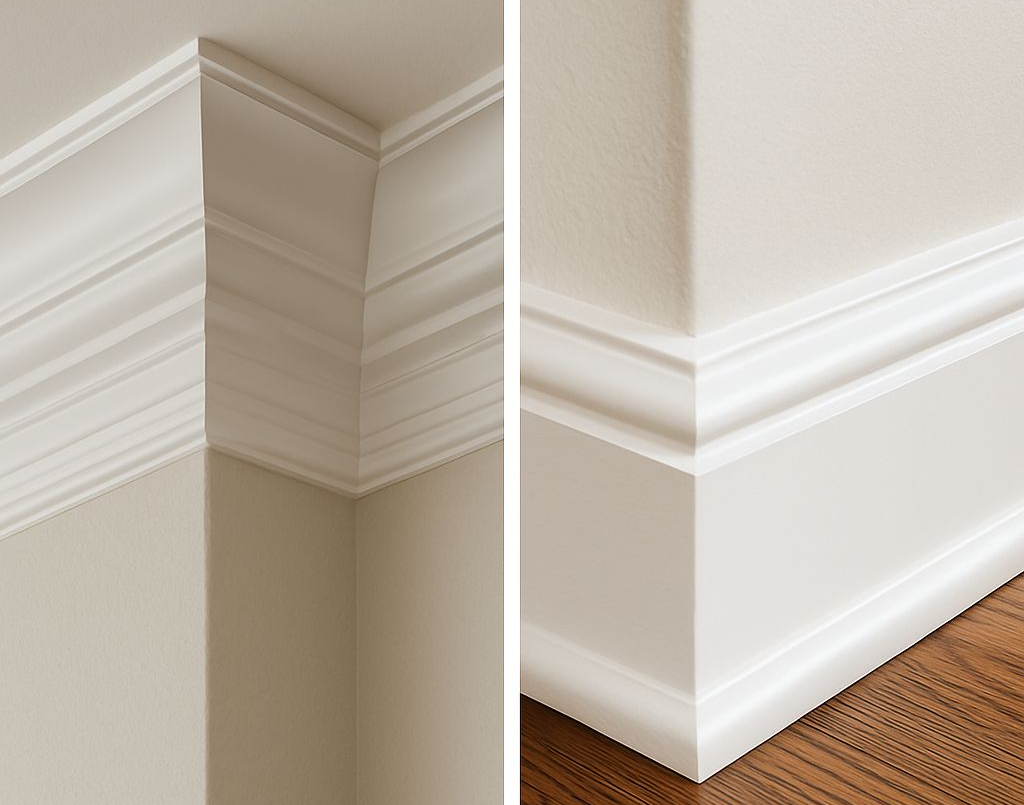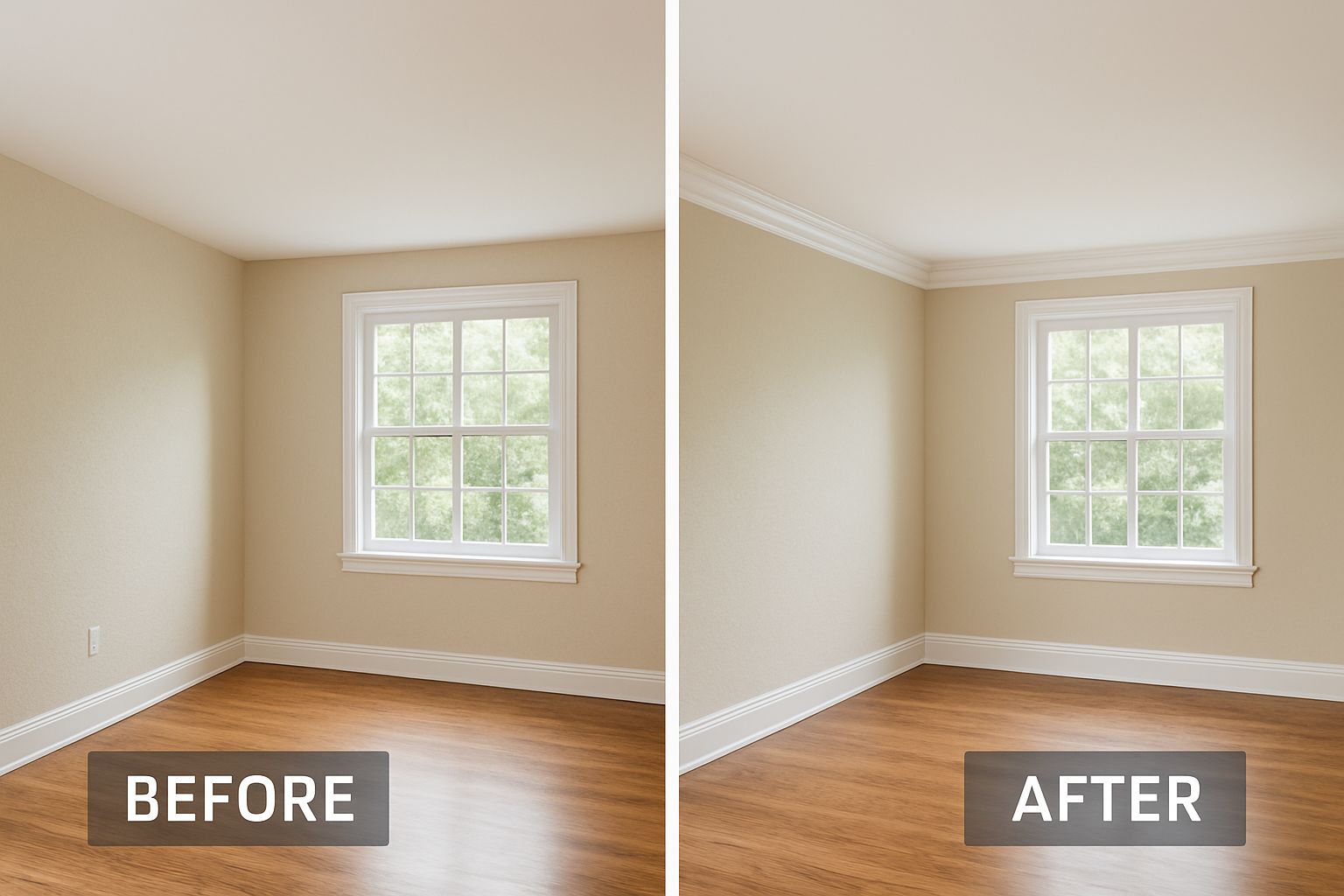Crown Molding vs. Baseboards: Which Trim Upgrade Adds More Value to Your Home?
Trim work is often underestimated—but it’s one of the most visually powerful ways to elevate a home’s interior. Whether you're remodeling your "forever home" or preparing it for resale, well-executed trim details can make the difference between a house that feels average and one that feels custom, complete, and high-end.
Two of the most impactful trim features?
Crown molding and
baseboards.
In this guide, we’ll explore what they are, how they differ, when to use them, and—most importantly—how they impact home value, style, and buyer appeal.
What Is Trim Work?
Trim refers to the finished woodwork that covers gaps and transitions in your home’s interior: where walls meet floors, ceilings, doors, and windows. While it's functional, its primary role is aesthetic enhancement.
Professional trim work:
Frames a space and gives it character
Highlights architectural style
Adds value by signaling attention to detail and quality craftsmanship
Crown molding and baseboards are two of the most prominent and strategic trim upgrades.

Crown Molding: Elevating the Upper Edge
What It Is
Crown molding is decorative trim installed where walls meet the ceiling. It visually "crowns" a room, adding height, elegance,
and proportion. Originally rooted in classical architecture, crown molding is now a staple in luxury interiors.
Where It Works Best
- Living rooms and formal spaces (adds elegance and visual height)
- Bedrooms (especially primary suites with high ceilings)
- Hallways and dining rooms (adds cohesion and flow between rooms)
Benefits
- Makes ceilings feel higher
- Adds a refined, finished look
- Pairs beautifully with wainscoting or custom trim walls
See examples of our crown molding work

Baseboards: The Silent Workhorse of Interior Design
What They Are
Baseboards are trim pieces installed along the bottom of interior walls, where they meet the floor. They protect walls from scuffs, create smooth transitions, and give the room a clean “foundation.”
Where They Matter Most
- Throughout the entire home (especially in open-plan spaces)
- Areas with high foot traffic like hallways, staircases, and mudrooms
Benefits
- Conceals gaps between flooring and drywall
- Adds subtle style and cohesion
- Complements other trim features like door casings and crown molding
Crown Molding vs. Baseboards: Which Should You Choose?
The best answer? Ideally,
both. But here’s how to decide where to start:
Home Value Insight:
Buyers and appraisers often associate crown molding with luxury, and updated baseboards with quality upkeep. If your home has outdated or builder-grade trim, both are smart investments—especially before listing.
Material & Profile Selection: The Designer’s Touch
At Fogg Carpentry, we help homeowners choose the right profile, material, and installation method based on their goals.
Popular materials include:
- MDF: Budget-friendly, great for paint
- Poplar or Pine: Smooth grain, ideal for custom cuts
- Oak or Maple: More durable, better for stain finishes
- PVC: Best for moisture-prone areas like basements
Popular profiles:
- Classic Colonial: Timeless and versatile
- Modern Flat Stock: Clean, minimal, perfect for modern homes
- Ornate Curves: Adds drama and formality
Custom profiles can be created for homes with unique themes or architectural character.

Why Custom Trim Installation Matters
Pre-fab trim kits often lead to misaligned corners, uneven reveals, or poor paint adhesion. A professional custom finish carpenter ensures:
- Perfect cuts that match your home’s measurements
- Seamless transitions between walls, floors, and ceilings
- Design continuity across spaces
Custom trim is also more adaptable—allowing us to work around irregular walls, existing cabinetry, or integrate lighting and tech features.
Explore our custom finish carpentry services in Rockville
Ideal Projects to Combine Trim Upgrades
- Full-room remodels (kitchen, bathroom, or basement)
- Open-concept living areas that lack definition
- Staging before selling—adds high-impact upgrades without major construction
- Trim refreshes on older homes with dated or worn-out materials
When baseboards and crown molding are installed together, they visually anchor the space while lifting the eye—creating a polished, high-end finish.
Working with Fogg Carpentry
As Rockville’s custom trim experts, we specialize in:
- Crown molding installation
- Baseboard replacement
- Full trim packages for remodels
- Custom profiles to match your home’s design
Serving Rockville, Bethesda, Potomac, Silver Spring, and the greater DMV region.
Whether you’re prepping to sell or enhancing your forever home, we’ll help you make the right trim choices—and bring them to life with precision and care.
FAQ
Can I install crown molding and baseboards at the same time?
Yes, and it’s often more efficient. You save on labor costs and get a cohesive, professionally matched finish throughout the space.
What’s the most popular crown molding style in Rockville homes?
Traditional colonial and stepped modern profiles are common, but we customize based on each home’s aesthetic and layout.
Is it worth replacing baseboards if I’m not remodeling the whole room?
Absolutely. Worn or short baseboards can make a room feel dated—even if everything else is updated.
How long does trim installation take?
Most single-room installs take 1–2 days. Full-home trim packages vary based on scope and square footage.
Ready to Upgrade Your Trim?
We offer
free in-home estimates and custom design guidance to help you choose the best options for your space.
Let’s bring clean lines, timeless detail, and custom craftsmanship to your home.

